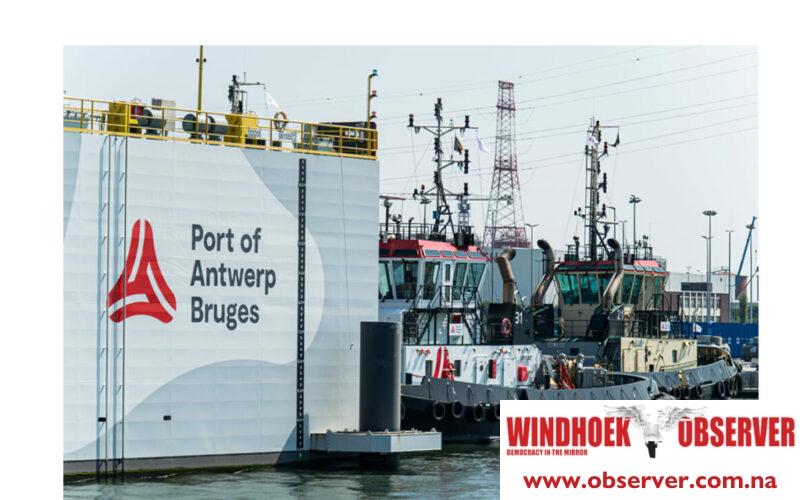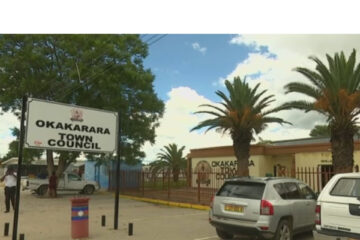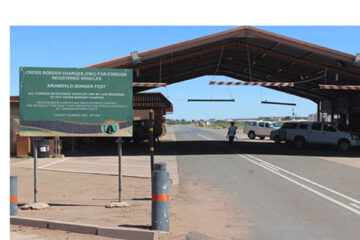Niël Terblanchë
The Port of Antwerp-Bruges plans to invest approximately US$265 million to develop a hydrogen and ammonia storage and export facility at the port of Walvis Bay.
The Namibian Ports Authority and the Port of Antwerp-Bruges are also participating and will jointly manage the new facilities once they are constructed.
It is part of an ambitious plan to make Namibia a frontrunner in the global green hydrogen economy and supply the alternative energy source both to passing ships and industrial users in Belgium, Germany, and other industrial clusters in Europe.
The Belgian, King Phillippe and President Nangolo Mbumba, unveiled the plan during their visit to Walvis Bay last Thursday.
They presided over the ceremonial first filling of a dual-fuel truck at the hydrogen refuelling station, which will be operational as part of the Cleanenergy Green Hydrogen site in the fourth quarter of 2024, during the event.
Cleanergy Solutions Namibia is a joint venture between CMB.TECH and the Ohlthaver & List (O&L) Group, is a privately held group of companies with interests ranging from food to technology, steel, marine engineering, and real estate.
The Cleanenergy Green Hydrogen facility uses only solar energy for the on-site production of green hydrogen.
The hydrogen refuelling station for hydrogen-powered trucks, port equipment, railway applications, and small ships will be among the initial projects.
A member of the business delegation that accompanied the monarch on his Namibian tour, Cie Maritime Belge SA, a Belgian shipping company, said it expects green hydrogen production in Namibia to start in the fourth quarter, a project that could see US$3.5 billion in investment over the next five years.
The Antwerp-based shipping company seeking to power its fleet plans to open the first stage of the hydrogen fuel and ammonia project through a joint venture with Namibia’s Ohlthaver & List Group.
The facility will initially produce 400 kilograms of hydrogen daily powered by a 5MW solar plant near Walvis Bay.
The estimated cost of construction is US$30 million. The project, known as Cleanergy, is part of a plan by the arid southern African nation to exploit some of the world’s best solar radiation and tap into Europe’s demand for green fuels.
If successful, along with recent oil finds, it could transform the economy of the Namibian nation, which currently relies on tourism, fishing, and diamond mining for revenue.
“Our customers are asking us to clean up our act to make sure that we don’t emit carbon dioxide anymore. So, we need to find an alternative for diesel,” Alexander Saverys, CMB’s chief executive officer, said.
“We wanted to be in a country where there’s an abundance of cheap renewable energy, and Namibia is that country,” he added.
An ammonia terminal at Walvis Bay Port will follow the expansion of the CMB plant.
CMB is also planning to construct a 250,000-tonne-per-year ammonia plant powered by solar at Arandis in the heart of the Namib desert. That will bring total project costs to about US$3.5 billion.
When completed, the project will allow CMB to venture into refuelling large ships that dock in Walvis Bay, which lies on the route around the tip of Africa.
At the site near Walvis Bay, solar energy is used to split water to generate hydrogen, which burns without emitting greenhouse gases and can be used to fuel trucks and small ships.
At Arandis, the hydrogen will be converted into ammonia, which is easier to transport and can be used to power large ships and heavy industry.
“All actors here share a vision of a green energy future. There is a bright future when I can see what we can accomplish together,” King Philippe said in a speech at the event.
The Namibian production plant will be its first outside Belgium, where it operates a small facility.
“Namibia has vast resources, including the sun and wind, that can be used to make hydrogen. But most importantly, we have a very like-minded vision and a very like-minded hydrogen strategy,” Tinne Van der Straeten, Belgium’s energy minister, said.
The two countries signed an agreement at the COP26 United Nations summit in Glasgow in 2021 to develop the green hydrogen industry.
“It is good that small countries can come together and do bigger things for other countries to follow,” Nangolo Mbumba, Namibia’s president, said in a speech at the event.
Partners from Belgium and Namibia devised a plan to develop the continent’s hydrogen infrastructure for the production and export of energy sources, as well as launch Africa’s first hydrogen-fueled vessel.




